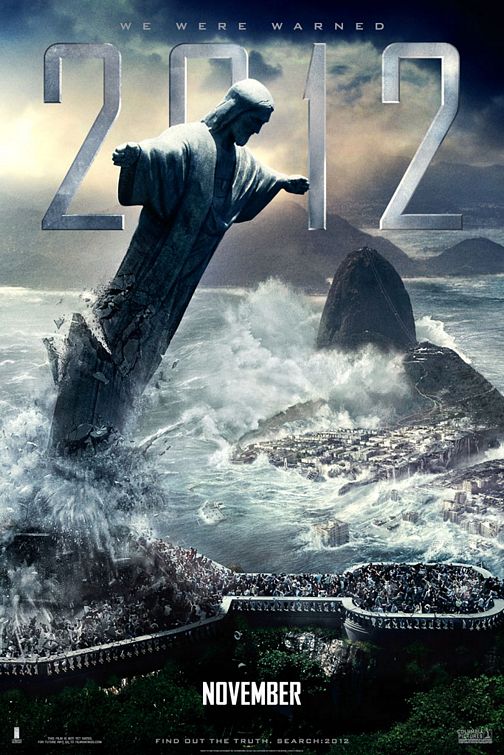Alright. I’m going to be upfront about this: I’m a sucker for disaster films. I have an appetite for destruction. I love the chaos, the unabashed melodrama, the sheer spectacle—the more epic, the more over the top the scenario, the happier I am. If Hollywood ever produces a movie in which Godzilla surfs the Titanic down the face of a tidal wave with a flaming spaceship in one claw and a vial of bubonic plague in the other, I will be the first person in line, and I will probably never, ever need to see another movie. Until that magical day arrives, my friends, we have 2012.
It seems that director Roland Emmerich was on a mission to find out just how much destruction he could possibly cram into a two and a half hour movie, and the resulting Earth-wide demolition derby is so wild and ridiculous and occasionally baffling that it will undoubtedly be written off by many people as a just another mindless, big-budget tribute to computer generated visual overkill. But, honestly, I don’t care—no matter how ludicrous the backstory is, 2012 attempts to deliver a disaster film to end all disaster films, and it has a good time doing it. You know the end of Doctor Strangelove, when Slim Pickens gleefully rides the bomb into oblivion, hootin’ and hollerin’ all the way like a deranged rodeo clown?
This movie makes you feel exactly like that for 158 minutes. Who’s in?
I’ve always thought that destruction, as entertainment, operates according to its own logic, especially when it’s on the scale of total apocalypse or the annihilation of a entire planet…there’s a point where details take a backseat to spectacle, at least if we’re going to have any fun. Consider the Death Star—there are so many questions you could ask once you start really thinking about it: is there a janitorial staff? A cafeteria? Are there unisex bathrooms? I mean, are there any bathrooms? But honestly, the only two reactions that make any sense upon encountering the Death Star are: 1) “Holy shit.” and, 2) “How the hell do we blow that crazy thing up?” Maybe it’s true that the devil is always in the details, but who has time to worry about details when planets are exploding and the wrath of god is raining down on all sides in epic, fiery CGI glory? Sometimes you’ve just got to cue up some Carmina Burana, sit back and enjoy the ride.
So, yes: the entire premise of the film is based on a complete misunderstanding of the Mayan calendar, and the “scientific” explanations for the series of cataclysmic events ripping apart the planet are mostly laughable and dubious at best. If you want a cogent and believable doomsday scenario, this film is probably not for you. On the other hand, while hackneyed phrases like “fast-paced, action-packed entertainment” and “heart-pounding, exhilarating thrillride” are so threadbare and overused that they’ve become little more than critical white noise, sometimes you just have to call a spade a spade—a fiery, explosive, cataclysmic SPADE OF WHITE HOT, CHEESE-LADEN DOOM, perhaps—but a spade nonetheless.
Once the action gets going, the film centers around a gaggle of interrelated characters led by frustrated science fiction writer Jackson Curtis, played by John Cusack, heading up a solid cast which includes the excellent Chiwetel Ejiofor, Oliver Platt, Amanda Peet, Danny Glover and a wonderfully manic, scene-stealing Woody Harrelson. Cusack’s wry, vulnerable, everyman appeal doesn’t exactly light up the screen, but his willingness to be understated works in this case, as if he understands that the CGI destruction is the real star here and no amount of scenery chewing is going to change that fact. His performance is actually a refreshing change from Hollywood-certified “action heroes” like Cusack’s Con Air co-star Nicholas Cage, for example, who’s made piles of money in recent years by grunting, growling and sweating his way through similar roles like a constipated gorilla on a rampage.
Curtis’s earnest attempts to reconnect with his estranged wife and children against the backdrop of Armageddon and the other threads of human drama laced throughout the earthquakes and fire and flooding are hit-or-miss; at some points they seem forced and distracting, while other moments are genuinely affecting. Of course, 2012 doesn’t tug on the heartstrings as much as it smashes them repeatedly with a lead pipe: it’s no accident that the climax of the film includes not one but two adorable, big-eyed children, a tiny dog, and a sassy Tibetan grandmother (I can only assume that “sassy Tibetan grandmother” is the direct human equivalent of an emotional kitchen sink, tossed in out of nowhere for maximum sentimental appeal). And yet, as ridiculous as it all sounds on paper, I enjoyed every minute of it. What can I say? Disaster makes me happy; it’s cathartic and entertaining and really, really fun, if you don’t take it too seriously. I mean, it’s just the end of the world; why not sit back and enjoy it?
But if that’s not your thing, no worries: you can always see The Road instead…
Bridget McGovern is a lit nerd, a film geek, and a complete pop culture junkie. She enjoys David Bowie, roller coasters, and Shelley Winters in “The Poseidon Adventure” more than anyone probably should.










